N. Senapati1, R. K. Dhal2, T. K. Das3
1Department of Mathematics, Ravenshaw University, Cuttack, Orissa, 753003, India
2J.N.V. Paralakhemundi, Gajapati, Orissa, 761201, India
3Gurukula institute of technology, BBSR, Orissa, India
Correspondence to: T. K. Das, Gurukula institute of technology, BBSR, Orissa, India.
| Email: |  |
Copyright © 2012 Scientific & Academic Publishing. All Rights Reserved.
Abstract
The effects of chemical reaction in two dimensional steady free convective flow of an electrically conducting viscous fluid through a porous medium bounded by vertical surface with slip flow region has been studied. A uniform magnetic field is assumed to be applied transversely in the direction of the flow. . A chemically reactive species is emitted from the vertical surface into the flow field. The governing equations are developed by usual Boussinesq’s approximation .The problem is solved by regular perturbation technique. The expressions for the velocity field, temperature field, species concentration, shearing stress and the coefficient of heat transfer (in terms of Nusselt number) at the walls are obtained and their nature has been discussed by means of graphs. The effects of Hartmann number, the rarefaction parameter ,the porous parameter, Schmidt number and chemical reaction parameter on the flow are discussed.
Keywords:
MHD, Free Convective, Viscous Incompressible, Skin Friction, Nusselt Number, Chemical Reaction, Slip Flow Region
1. Introduction
The growing need for chemical reaction in industries and engineering requires the study of heat and mass transfer in the presence of different conditions and parameters with chemical reaction. There are many transfer processes governed by the combined action of buoyancy forces due to both thermal and mass diffusion in the presence of chemical reaction .It has many applications in nuclear reactor and combustion, solar collectors, drying, dehydration operations in chemical and food processing plants, polymer production etc.The effect of a chemical reaction on a moving isothermal vertical surface with suction has been considered byMuthucumaraswamy[1].Considering this on the study of a chemical reaction,Kandasamy et.al[2]considered the chemicalreaction and thermal stratification effects over a vertical stretching surface .Application of a chemical reaction to a micropolar flow over an isothermal vertical cone has been studied by El-Kabeir et. al.[3] .Ibrahim et .al.[4] have studied the chemical reaction and absorption effects on the unsteady mhd flow past a semi infinite verticalpermeable moving plate. Muthucumaraswamy et.al. [5] have studied the mass transfer effect on isothermal vertical oscillating plate in presence of chemical reaction. Makinde et.al.[6] have considered the heat and mass transfer effect on a flow with variable viscosity without chemical reaction . Recently the effect of chemical reaction on free convection flow through a porous medium bounded by a vertical surface was reported by Das. et al.[7]. Ibrahim et.al[8] have studied the chemical reaction effect on mhd boundary layer flow of heat and mass transfer over a moving vertical plate with suction. Also the chemical reaction effects on heat and mass transfer flow have been considered by Pal et. al.[9]and Ibrahim et.al[10].Rushi Kumar[11] have studied the effect of heat generation and radiation on mhd boundary layer flow in porous vertical flat plate.It is proposed to study the effects of chemical reaction on free convection mhd flow through porous medium bounded by vertical surface with slip flow region.
2. Formulation of Problem
We consider a steady flow of an incompressible viscous electrically conducting fluid through porous medium bounded by semi infinite vertical surface with slip flow region by making the following assumptions:1. All fluid properties except the density in the buoyancy force term are constant.2. The magnetic dissipation term in the energy equation is negligible.3. The Eckert number Ec is small.4. The magnetic Reynolds Number is so small that the induced magnetic field is negligible.5. A chemically reactive species is emitted from the vertical surface into magneto hydrodynamic flow field. It diffuses into the fluid, where it undergoes a homogenous chemical reaction. As the level of species concentration is very low, therefore heat generation due to chemical reaction is neglected.X’-axis is taken along semi vertical surface and Y’-axis is normal to it. A uniform magnetic field of strength H0 has been applied perpendicular to the vertical surface and the magnetic permeability μe is constant throughout the field.  and
and  are the temperature and
are the temperature and  are the mass concentration of surface and fluid respectively. Then by usual Boussinesq’s approximation the steady flow is governed by the following equations:
are the mass concentration of surface and fluid respectively. Then by usual Boussinesq’s approximation the steady flow is governed by the following equations: | (1) |
 | (2) |
 | (3) |
 | (4) |
 | (5) |
By integrating equation (1) ,we get  | (6) |
is the steady normal velocity suction on the surface.Let us introduce the following non-dimensional quantities: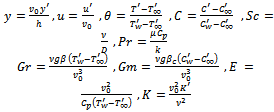 | (7) |
 where Pr is the Prandtl number, Sc is the Schmidt number, Gr is the Grashof number for heat transfer, Gm is the Grashof number for mass transfer, E is the Eckert number,
where Pr is the Prandtl number, Sc is the Schmidt number, Gr is the Grashof number for heat transfer, Gm is the Grashof number for mass transfer, E is the Eckert number,  the permeability parameter of the porous medium, R is chemical reaction parameter, h is rarefaction parameter and M is the Hartmann number. With the help of equations (6) and (7) the equations (2) to (5) reduce to
the permeability parameter of the porous medium, R is chemical reaction parameter, h is rarefaction parameter and M is the Hartmann number. With the help of equations (6) and (7) the equations (2) to (5) reduce to  | (8) |
 | (9) |
 | (10) |
with the corresponding boundary conditions  | (11) |
3. Method of Solution
In order to obtain solutions of coupled nonlinear system of equations (8) –(10) with boundary conditions (11) ,we expand  in the powers of Eckert number E(assuming very small)
in the powers of Eckert number E(assuming very small) | (12) |
Substituting equations (12) into equations (8) –(10) with boundary conditions,and equating the coefficients of same power of E and neglecting the higher power of E ,we get the following equations. | (13) |
 | (14) |
 | (15) |
 | (16) |
 | (17) |
 | (18) |
With corresponding boundary conditions | (19) |
By solving equations (13) – (18), using the boundary condition (19) ,we get the following | (19) |
 | (20) |
 | (21) |
where  ,
, The non-dimensional shearing stress
The non-dimensional shearing stress | (22) |
The non-dimensional Rate of heat transfer | (23) |
The non-dimensional rate of mass transfer 
4. Result and Discussion
In this paper we have studied the effects of Chemical Reaction on Free Convective Flow through a Porous Medium Bounded by Vertical Surface With Slip Flow Region. The effect of the parameters Gr, Gm, M, R,E ,h, Pr ,K and Sc on flow characteristics have been studied and shown by means of graphs . In order to have physical correlations, we choose suitable values of flow parameters. The graphs of velocity, temperature and mass concentration are taken w.r.t y. and the graphs of Nusselt number and Shearing stress are taken w.r.t. h.Velocity profiles: The velocity profiles are depicted in Figs 1-5. Figure-(1) )shows the effect of the parameter E on velocity at any point of the fluid, whenGr=2,Gm=2 ,K=2,M=2,h=1,Pr=7,Sc=2 and R=2 . It is noticed that the velocity increases with the increase of Eckert number (E). Figure-(2) shows the effect of the parameters Gm and Gr on velocity at any point of the fluid ,whenK=2,M=2,h=1,Pr=7,Sc=2 and R=2. It is noticed that the velocity increases with the increase of both modified Grashoff number (Gm ) and Grashoff number (Gr).Figure-(3) shows the effect of the parameters K and M on velocity at any point of the fluid ,when ,E =0.05Gm=2,Pr=7,Sc=2,Gr=2 and h=1 . It is noticed that the velocity increases with the increase of permeability parameter porous medium (K) and decreases with the increase of Hartmann number (M).Figure-(4) shows the effect of the parameters R and h on at any point of the fluid, whenE=0.05 ,Gm=2,Gr=2,K=2,Pr=7,Sc=2 and M=2. It is noticed that the velocity increases with the increase of both Reaction parameter (R) and rarefaction parameter(h).Figure-(5) shows the effect of the parameters Pr and Sc on at any point of the fluid, whenE=0.05 ,Gm=2,Gr=2,K=2,h=1,R=2 and M=2. It is noticed that the velocity increases with the increase of Prandtl number (Pr) and fluctuate then decreases for the increase of Schmidt number ( Sc). From all the figure of velocity the velocity reaches its maximum at a very short distance from the plate.Temperature profile: The temperature profiles are depicted in Figs 6-9. Figure-(6) shows the effect of the parameters Gr and Gm on Temperature profile at any point of the fluid, when E=0.05 ,Pr=2 ,Sc=2, K=2,h=1,R=2 and M=2. It is noticed that the temperature rises in the increase of both modified Grashoff number (Gm) and Grashoff number (Gr). Figure-(7) shows the effect of the parameters M,K and Pr on Temperature profile at any point of the fluid, whenE=0.05 ,Gr=2 ,Sc=2 ,h=1,R=2 and Gm=2.. It is noticed that the temperature falls with the increase of both permeability parameter porous medium (K) and Prandtl number (Pr) ,where as it rises with the increase of Hartmann number (M ).Figure-(8) shows the effect of the parameter E on Temperature profile at any point of the fluid, when E=0.05 ,Pr=2 ,Sc=2, K=2,h=1,R=2 and M=2. It is noticed that the temperature rises in the increase of Eckert number (E).Figure-(9) shows the effect of the parameters R and h on Temperature profile at any point of the fluid ,when E=0.05 ,Gr=2 ,Sc=2 ,K=2,M=2,Pr=2 and Gm=2. It is noticed that the temperature falls with the increase both chemical reaction parameter (R) and rarefaction parameter (h). Mass concentration profile: The mass concentration profiles are depicted in Fig -10 only. Figure-(10) shows the effect of the parameters R and Sc on mass concentration profile at any point of the fluid in the absence of other parameters. It is noticed that the mass concentration decreases with the increase of both reaction parameter (R) and Schmidt number( Sc) . Shearing stress: The Shearing stresses of velocity are depicted in Figs 11-12. Figure-(11) shows the effect of the parameters K,M,E and R on shearing ,when Sc=2,Pr=2,Gr=2 and Gm=2. It is noticed that shearing stress at surface decreases with the increase of both Hartmann number (M ) and Eckert number (E),where as increases with the increase of reaction parameter (R) and permeability parameter porous medium (K). Figure -(12 )- shows the effect of the parameters of Sc,Pr,Gr and Gm on Shearing stress when K=2,M=2,R=2 and E=0.05.. It is noticed that the shearing stress of at the surface decreases with the increase of Grashoff number (Gr) ,where as increases with the increase of modified Grashoff number (Gm), Prandtl number (Pr) and Schmidt number (Sc). Nusselt number: The Nusselt numbers of temperature are depicted in Figs 13-14. Figure -(13 -14) shows the effect of the parameters of heat transfer at surface, when .It is observed that the rate of heat transfer increases at surface with the increase of permeability parameter porous medium ( K) , reaction parameter (R), Prandtl number (Pr) ,whereas it decreases with the increase of Eckert number (Ec), Hartmann number (M ), Grashoff number ( Gr) and modified Grashoff number (Gm).  | Figure 1. Effect of E on velocity profile when Gr=2,Gm=2 ,K=2,M=2,h=1,Pr=7,Sc=2 and R=2 |
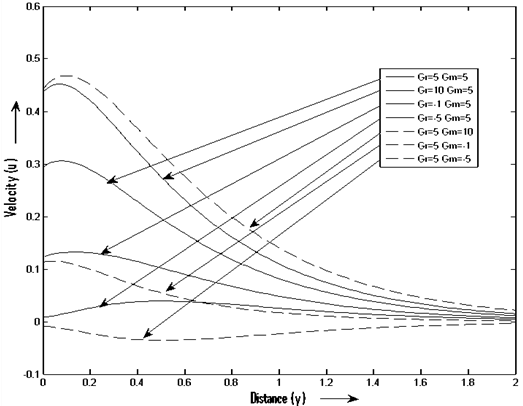 | Figure 2. Effect of Gr and Gm on velocity profile when E=0.05 ,K=2,M=2,h=1,Pr=7,Sc=2 and R=2 |
 | Figure 3. Effect of K andM on velocity profile when E=0.05 ,Gm=2,Gr=2,h=1,Pr=7,Sc=2 and R=2 |
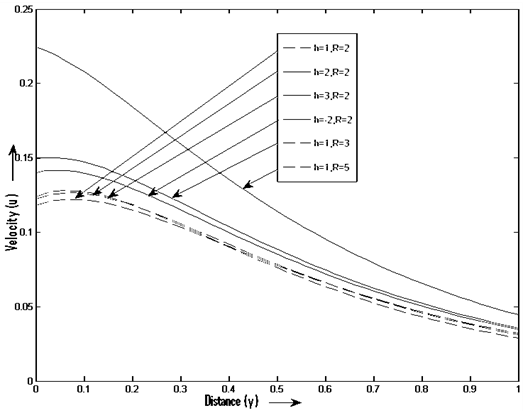 | Figure 4. Effect of h and R on velocity profile when E=0.05 ,Gm=2,Gr=2,K=2,Pr=7,Sc=2 and M=2 |
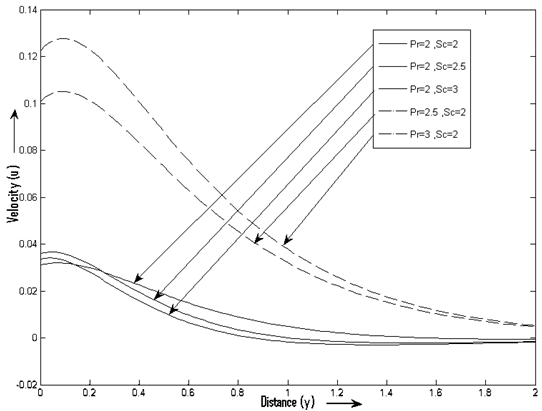 | Figure 5. Effect of Pr and Sc on velocity profile when E=0.05 ,Gm=2,Gr=2,K=2,h=1,R=2 and M=2 |
 | Figure 6. Effect of Gr and Gm on Temperature profile when E=0.05 ,Pr=2 ,Sc=2, K=2,h=1,R=2 and M=2 |
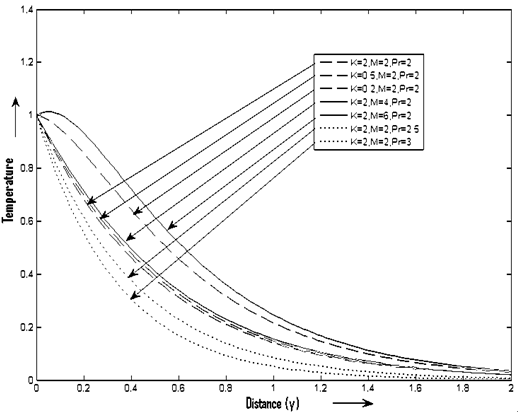 | Figure 7. Effect of K,M and Pr on Temperature profile when E=0.05 ,Gr=2 ,Sc=2 ,h=1,R=2 and Gm=2 |
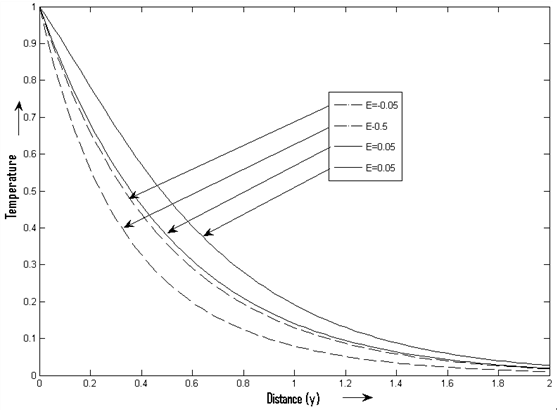 | Figure 8. Effect of E on Temperature profile when Pr=2 ,Gr=2 ,Sc=2 ,h=1,R=2,K=2,M=2 and Gm=2 |
 | Figure 9. Effect of R and h on Temperature profile when E=0.05 ,Gr=2 ,Sc=2 ,K=2,M=2,Pr=2 and Gm=2 |
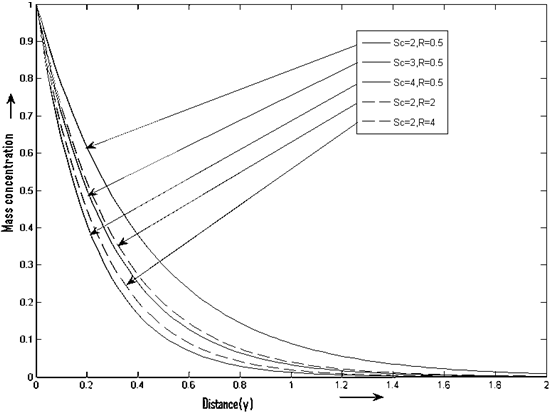 | Figure 10. Effect of Sc and R on Mass concentration profile in the absence of other parameters |
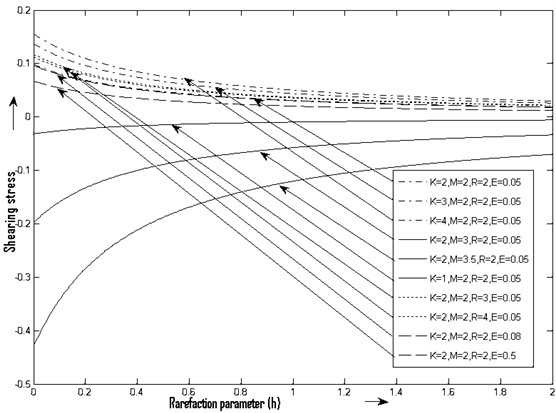 | Figure 11. Effect of K,R,E and R on Shearing stress when Sc=2,Pr=2,Gr=2 and Gm=2 |
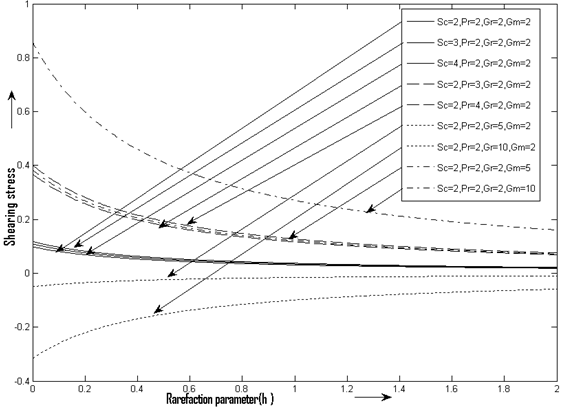 | Figure 12. Effect of Sc,Pr,Gr and Gm on Shearing stress when K=2,M=2,R=2 and E=0.05 |
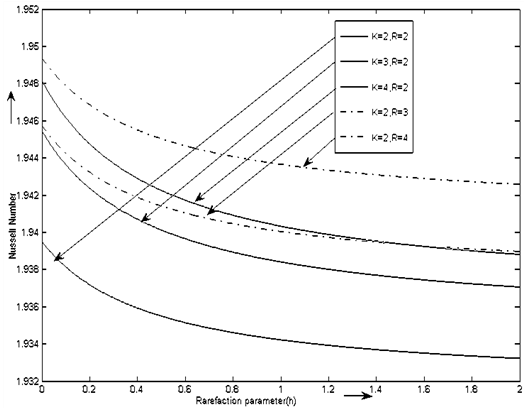 | Figure 13. Effect of K and R on Nusselt Number when Pr=2,Gr=2,Gm=2,M=2 and E=0.05 |
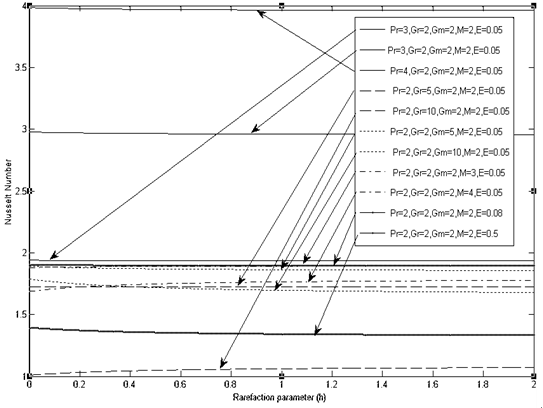 | Figure 14. Effect of Pr,Gr,Gm,M,and E on Nusselt Number when K=2,R=2 and Sc=2 |
5. Conclusions
ⅰ The velocity increases with the increase in E, Gr, K, Pr, Gm,h and R, also decreases with the increase in of M and Sc. The velocity near the surface is higher then gradually decreases to zero.ⅱ The temperature falls for the increasing of Pr,R,K and  and also rises for the increase Gr,Gm,M and E .The excess heat produces during the chemical reaction is diminished due to the presence of porous medium and slip flow region.ⅲ The mass profile decreases for the increasing of Sc and R. ⅳ The shearing stress at the surface reduce to zero for the increase of h.Also increases for the increase of K, R, Sc, Pr and Gm and decreases for other parameters.ⅴ The rate of heat transfer at the surface during the process of chemical reaction increases in the presence porous medium with the increase of Prandtl number and decreases for other parameters.
and also rises for the increase Gr,Gm,M and E .The excess heat produces during the chemical reaction is diminished due to the presence of porous medium and slip flow region.ⅲ The mass profile decreases for the increasing of Sc and R. ⅳ The shearing stress at the surface reduce to zero for the increase of h.Also increases for the increase of K, R, Sc, Pr and Gm and decreases for other parameters.ⅴ The rate of heat transfer at the surface during the process of chemical reaction increases in the presence porous medium with the increase of Prandtl number and decreases for other parameters.
References
| [1] | R. Muthucumarswamy ,Effects of chemical reaction on a moving isothermal vertical a surface with suction, Acta Mech. ,155,65-70 ,2002 |
| [2] | R. Kandasamy et.al, chemical reaction ,heat and mass transfer on MHD flow over a vertical stretching surface with heat source and thermal stratification effects ,Int.J.heat mass transfer,48,4554-4561 ,2005 |
| [3] | S.M.M.El-Kabeir and M.M.M.Abdou ,chemical reaction, heat ,mass transfer on Mhd flow over a vertical isothermal cone surface in micropolar fluids with heat generation/absorption,Appl.Math .Sci-1,34,1663-1674 ,2007. |
| [4] | F.S. Ibrahim , A.M.Elaiw and A.A.Bak , Effect of the chemical reaction and radiation absorption on the unsteady MHD free convection flow past a semi infinite vertical permeable moving plate with heat source and suction. Comm. In Nonlinear Sc. Num. Simulation vol.13, 1056-1066 ,2008 . |
| [5] | R.Muthucumaraswamy, and B. Janakiraman, mass transfer effects on isothermal vertical oscillating plate in presence of chemical reactions, Int. J. of Appl. Math. and Mech. 4(1): 66-74, 2008. |
| [6] | O. D. Makinde, A. Ogulu, The effect of thermal radiation on the heat and mass transfer flow of a variable viscosity fluid past a vertical porous plate permeated by a transverse magnetic field, Chemical Engineering Communications,195 (12), 1575 -1584,2008. 7). G.C.Das et. al. , Effect of chemical reaction on free convection flow through a porous medium bounded by a vertical surface,J.Eng.Phy& Them Phy.,83,No-1,130-140,2010. |
| [7] | S.Y. Ibrahim and O.D.Makinde, Chemically reacting MHD boundary layer flow of heat and mass transfer over a moving vertical plate with suction. Scientific Research and Essays Vol.5 (19) , 2875-2882,2010. |
| [8] | D. Pal and B. Talukdar , Perturbation analysis of unsteady magneto hydro dynamic convective heat and mass transfer in a boundary layer slip flow past a vertical permeable plate with thermal radiation and chemi cal reaction. Communications in Nonlinear Science and Numerical Simulationpp.1813-1830,2010 |
| [9] | S.Y. Ibrahim , O.D.Makinde , Chemically reacting MHD boundary layer flow of heat and mass transfer past a moving vertical plate with suction. Scientific Research and Essay, 2010 (In Press). 11) Rushi Kumar.B, Effect of heat generation and radiation on Mhd boundary layer flow in porous vetical flat plate,International Journal of Mathematical Archive- 3 (1)-221,Jan. 2012 . |

 and
and  are the temperature and
are the temperature and  are the mass concentration of surface and fluid respectively. Then by usual Boussinesq’s approximation the steady flow is governed by the following equations:
are the mass concentration of surface and fluid respectively. Then by usual Boussinesq’s approximation the steady flow is governed by the following equations:






 where Pr is the Prandtl number, Sc is the Schmidt number, Gr is the Grashof number for heat transfer, Gm is the Grashof number for mass transfer, E is the Eckert number,
where Pr is the Prandtl number, Sc is the Schmidt number, Gr is the Grashof number for heat transfer, Gm is the Grashof number for mass transfer, E is the Eckert number,  the permeability parameter of the porous medium, R is chemical reaction parameter, h is rarefaction parameter and M is the Hartmann number. With the help of equations (6) and (7) the equations (2) to (5) reduce to
the permeability parameter of the porous medium, R is chemical reaction parameter, h is rarefaction parameter and M is the Hartmann number. With the help of equations (6) and (7) the equations (2) to (5) reduce to 



 in the powers of Eckert number E(assuming very small)
in the powers of Eckert number E(assuming very small)










 ,
, The non-dimensional shearing stress
The non-dimensional shearing stress
















 and also rises for the increase Gr,Gm,M and E .The excess heat produces during the chemical reaction is diminished due to the presence of porous medium and slip flow region.ⅲ The mass profile decreases for the increasing of Sc and R. ⅳ The shearing stress at the surface reduce to zero for the increase of h.Also increases for the increase of K, R, Sc, Pr and Gm and decreases for other parameters.ⅴ The rate of heat transfer at the surface during the process of chemical reaction increases in the presence porous medium with the increase of Prandtl number and decreases for other parameters.
and also rises for the increase Gr,Gm,M and E .The excess heat produces during the chemical reaction is diminished due to the presence of porous medium and slip flow region.ⅲ The mass profile decreases for the increasing of Sc and R. ⅳ The shearing stress at the surface reduce to zero for the increase of h.Also increases for the increase of K, R, Sc, Pr and Gm and decreases for other parameters.ⅴ The rate of heat transfer at the surface during the process of chemical reaction increases in the presence porous medium with the increase of Prandtl number and decreases for other parameters. Abstract
Abstract Reference
Reference Full-Text PDF
Full-Text PDF Full-Text HTML
Full-Text HTML